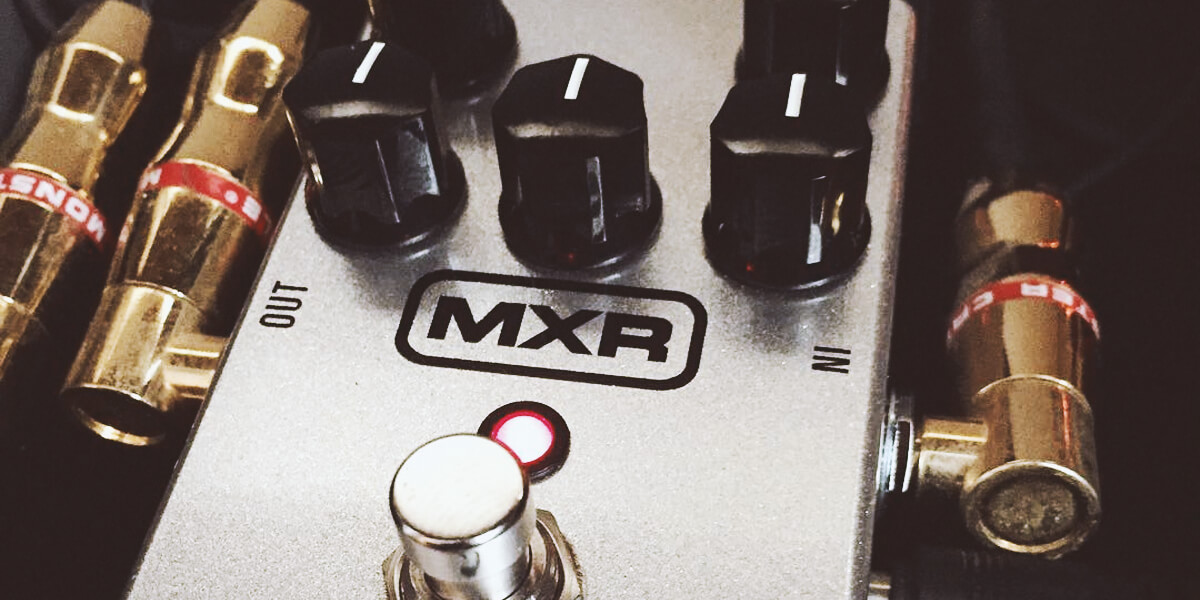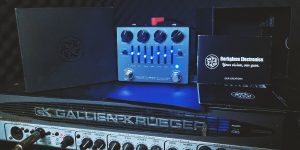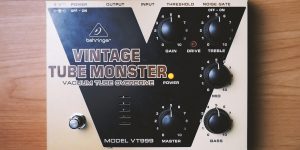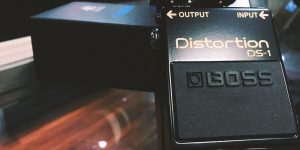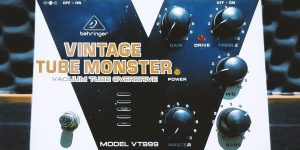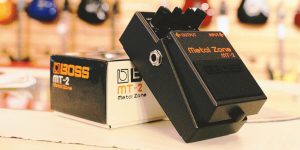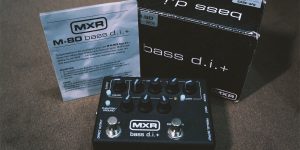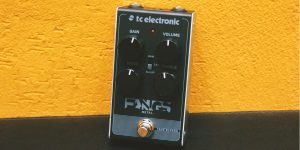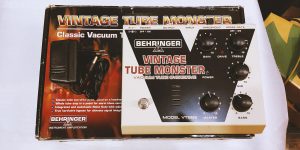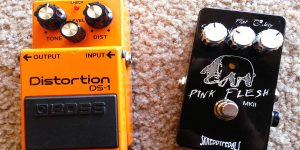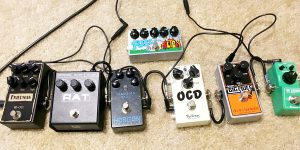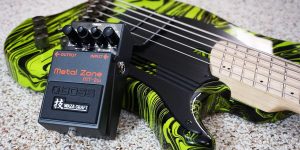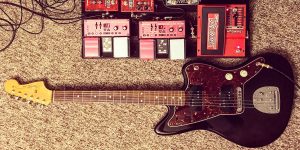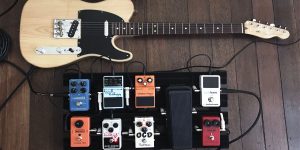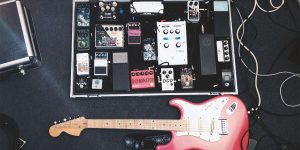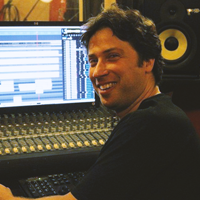Distortion pedals are an indispensable attribute of any guitarist’s pedalboard. This famous effect can be heard in the most popular and even iconic music compositions. But what if you are a beginner musician and your budget is limited? In this review, I will tell you about the best distortion pedals under $100. And trust me, you can find some really good ones in this rank. Also, I will tell you some important points about this kind of pedal.
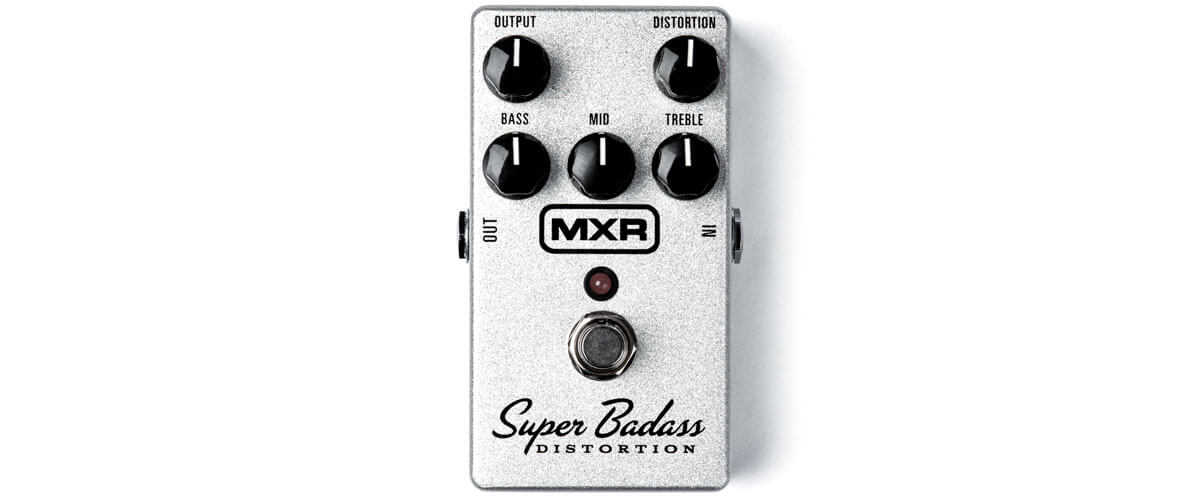
Budget distortion pedal comparison table
| Name | Controls | Connectors | Power Supply | Review |
|---|---|---|---|---|
| MXR M75 best overall | pedal switch, tone, level, dist, EQ mid freq, EQ high freq, EQ low freq | input jack: 1/4-inch, output jack: 1/4-inch, DC IN jack | battery (9V), DC adaptor (9V) | Review |
| Boss DS-1 budget | pedal switch, tone, level, dist | input jack: 1/4-inch, output jack: 1/4-inch, DC IN jack | Alkaline battery (9V, 6LR61) or Carbon-zinc battery (9V, 6F22), AC adaptor | Review |
| JOYO JF-03 under 50 | pedal switch, tone, level, dist, EQ mid freq, EQ high freq, EQ low freq | input jack: 1/4-inch, output jack: 1/4-inch, DC IN jack | Carbon-zinc battery (9V, 6F22), DC adaptor (9V) | Review |
Things to know before buying the first distortion pedal
Controls and Equalization
There are no pedals in the world that you can turn on and play. Just like any other instrument, you have to adjust them to your tastes by adjusting higher or lower frequencies, setting an overdrive for a heavier metal sound, or the minimum level for a pop style.
The more controls and settings you have on your pedal, the more opportunities you have to squeeze the sound you want out of it. So the most versatile pedals have the biggest functionality. However, specialized monofunctional pedals in a chain with others can give you a more unique crisp effect. So it all depends on what genre you play, what you expect from the pedal, and how much time you’re willing to spend setting it up.
Bypass
You may often see such a feature as True Bypass in pedal descriptions. It is a great option because it ensures that the signal from your guitar goes uninterrupted to your amplifier, even when the effect pedal is turned off. No interference or load like conventional pedals, direct transmission through the input to the output. In case you don’t know if your pedal has True Bypass, just turn it off and see whether the signal keeps coming in. So, the need for such a pedal is up to you to decide. After all, while it is an obvious advantage, it’s not perfect. For example, such pedals often make noise when shifting. Practice and time will tell you the answer to this question.
Power source
The pedal can be powered by either a power supply or a battery. Of course, using a battery saves you from unnecessary wires, as well as costs, because buying a power supply can be expensive if not included in the package. Also, you don’t have to look for an electrical outlet if you often play outside your home or studio. But the batteries can run out, so carry a spare or the same power supply.
Best budget distortion pedal reviews
MXR M75 – best overall
Well, some names speak for themselves. And in this MXR M75 review, I'll introduce you to an effect pedal that bears the proud name of Super Badass Distortion. MXR was a pioneer in making pedals, but they've honed their craftsmanship quite a bit over the decades. So, in this case, you get a solid, robust device with a great distortion range. Also, the pedal works with single-coil pickups and humbuckers equally well. Now, let's look at the inside.
Build and design

The MXR M75 is the epitome of elegance, especially when you consider the fact that the top panel of the enclosure, which is small, has five knobs, a foot switcher, and an On/Off indicator. The IN/OUT connectors are on the side panels. The case itself has a silver color and is sturdy enough, as well as the control knobs. So you can safely stomp on it, and it will hold up. At the same time, the manufacturer has made the body thinner, which means that the pedal itself is much lighter than the others, making it even more portable and comfortable. The M75 measures 2.12", 2.62", and 4.37" and weighs 0.53 lbs.
Features
As for the MXR M75 Super Badass Distortion features, they are capable of impressing. This pedal has five control knobs. The top row is Output and Distortion. You will be able to sound really dirty and ferocious. The bottom row is the 3-band Bass, Mid, and Treble EQ. These will give you a very wide range of tone control because Bass works with the lower frequencies, and Treble works with the high frequencies, giving you a much wider range of tone than conventional controls. Accordingly, the Mid - mid-range can be cut out altogether if you suddenly want to. But the main thing is that all the control is just in your hands. Feel free to experiment and spend enough time practicing. Then, you can achieve a classic vintage feel with the right setup.
There's also True Bypass. The M75 runs on a 9V battery or a Dunlop ECB003 adapter, which are not included. You can also use DC Brick, Iso-Brick, and Mini Iso-Brick power supplies.
Sound
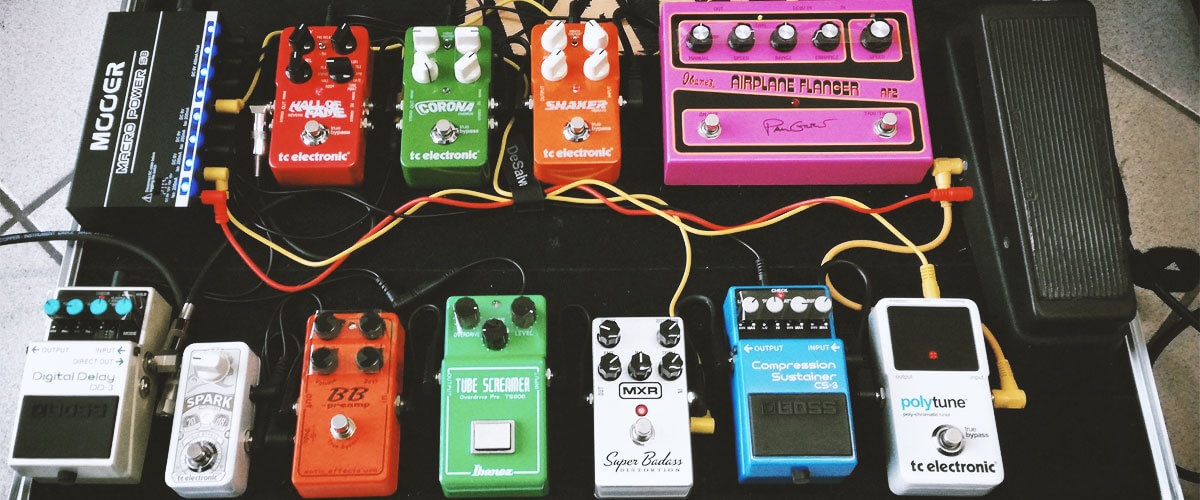
I consider this pedal versatile, and that's not just about its controls and capabilities but also about how the MXR M75 sounds. Whether you use it by itself or connect it to your pedalboard, it will work the way you expect it to work. Blues, grunge, rock riffs, and even ferocious metal tones are available to it. The M75 can be "wicked" or "soft" and crisp; it can be sharp or smudged. My point is that it can do it all because pedals with a single purpose - usually fulfill it 100%. So it all depends on what you want to get. I spent a lot of time tuning and reconnecting the circuit to get the tones I wanted, but in the end, I got them! So I can recommend it with a clear conscience. All it takes is a reserve of patience to explore its capabilities. And if you love the electric guitar as much as I do, you'll be fine.
Key specs
- Controls: pedal switch, tone, level, dist, EQ mid freq, EQ high freq, EQ low freq.
- Connectors: input jack: 1/4-inch, output jack: 1/4-inch, DC IN jack.
- Power Supply: battery (9V), DC adaptor (9V).
- Size (WxDxH), inch/cm: 6x4.5x2.7/15.2x11.4x6.8
- Weight oz/g: 3.1/90.
I think the MXR M75 is the best distortion pedal under $100, and that’s not just about its controls and capabilities but also about how it sounds. Blues, grunge, rock riffs, and even ferocious metal tones are available to it. A definite leader in sound and versatility!
Boss DS-1 – budget
In this Boss DS-1 review, I will tell you about one of today's most popular and selling distortion pedals. It was introduced back in 1978 and was produced in Japan and later in Taiwan. And in the 2000s, Boss became part of Roland. However, these events did not affect the quality of the product, and numerous modifications only improved the basic model.
The bright orange pedal has incredible durability, so you can often find many used models on the market. And I assure you, they are still as great as they were years ago. Another attractive aspect of the Boss DS-1 is its price, which is surprisingly low for such a celebrity. So let's take a closer look at it.
Build and design
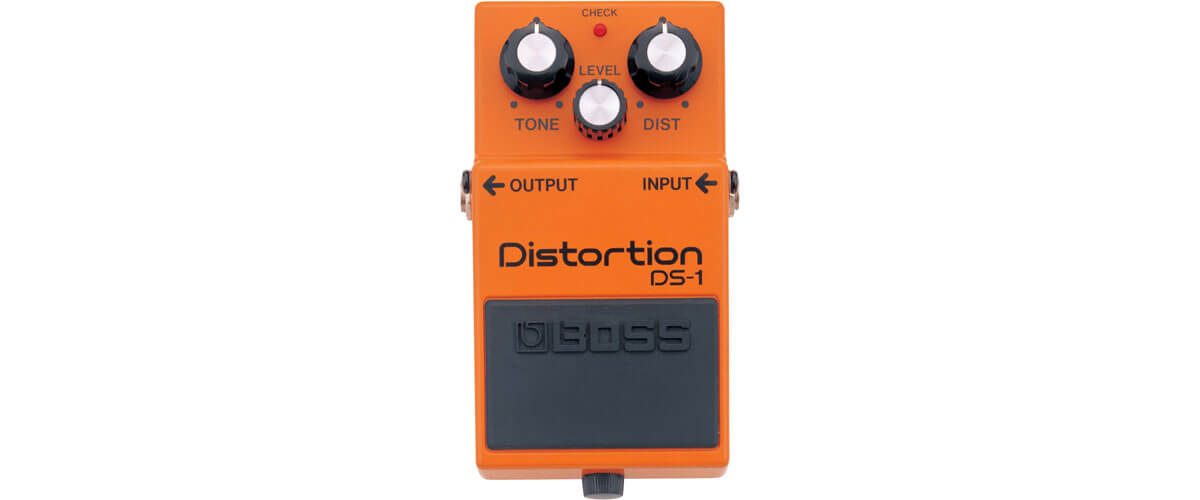
The design of the pedal has not changed since its creation and is recognizable all over the world. The case is incredibly sturdy, and it can last you for a very long time. You don't have to worry about its integrity; use it with pleasure!
The Boss DS-1 is pleasant to look at and easy to operate. In addition to the standard input and output jacks you can use to connect it to your circuit, it also has three control knobs and a foot pedal. There is a CHECK indicator to indicate the control battery. So nothing can throw you off. The distortion pedal is portable and will fit in your pocket - that's how compact it is. With a weight of 13 oz, it measures only 2-7/8 inches, 5-1/8 inches, and 2-3/8 inches. So this is an option where you can use it wherever you want.
Features
Let's get down to the features of the Boss distortion DS-1. As I have already written, it is very simple and comfortable. For example, the on/off pedal is very smooth and doesn't snag or break. And the 1/4" DC input and output connectors are telephone-type with a 20 dBu rating. The pedal is powered by an alkaline battery (9V, 6LR61) or a zinc-carbon battery (9V, 6F22), but you'll need to buy an AC adapter.
There are only three controls: TONE, DIST, and LEVEL. The latter essentially controls the volume, allowing you to use the Boss DS-1 at a concert with maximum sound or home by setting it to the minimum. TONE - The frequency control, their equalizer, is a standard control for most pedals, as it is for an amp or electric guitar. In the left position, you get more bass; in the right position, you get more treble. With DIST, I hope everything is clear. With this control, you turn the clean sound of your guitar into a distorted and crunchy sound. Perfect for performing heavy genres.
Sound
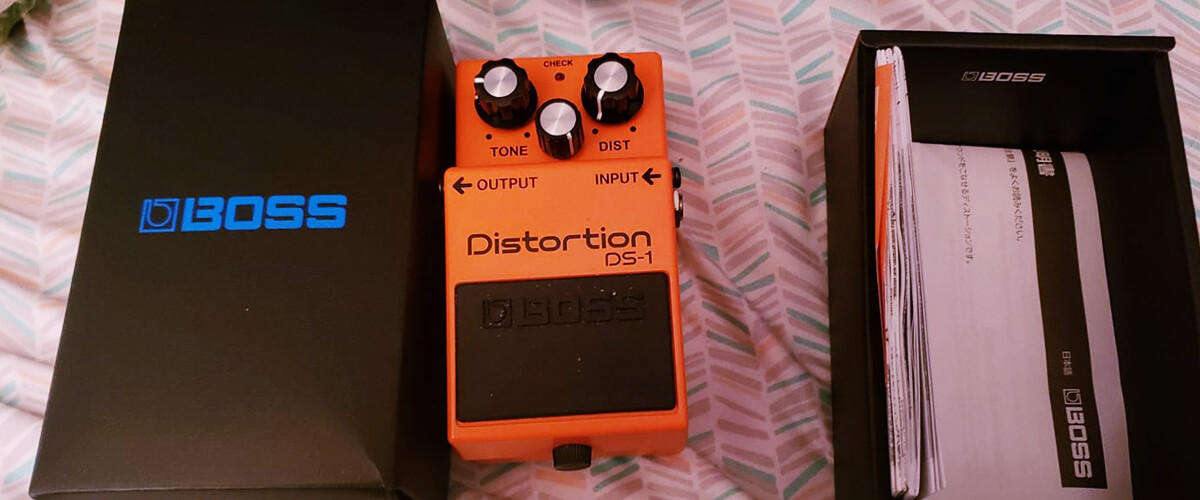
To conclude all the above, it is only necessary to tell how the Boss distortion pedal sounds. I have a tube amplifier, and there were no problems. But I have encountered comments about it not being very good with solid-state ones. So, just keep that in mind, and check beforehand.
Otherwise, in my opinion, this pedal is perfect for your circuit. And, of course, it's suitable for metal and rock, delivering a fun, high-quality overdrive. Excellent wide-range tone, low gain, warmth, and harshness - a combination worthy of old-school masterpieces. For solos, you can press it on an already distorted sound to achieve more volume and balance the sound.
Still need proof? Steve Vai, Joe Satriani, Daf Aldrich, Mike Stern, and other legends have used the Boss DS-1. So I think it's worth you, too.
Key specs
- Controls: pedal switch, tone, level, dist.
- Connectors: input jack: 1/4-inch, output jack: 1/4-inch, DC IN jack.
- Power Supply: Alkaline battery (9V, 6LR61) or Carbon-zinc battery (9V, 6F22), AC adaptor.
- Size (WxDxH), inch/cm: 2.8x5x2.3/7.3x12.9x5.9.
- Weight oz/g: 13/360.
The great distortion pedal for the budget is the Boss DS-1, one of today’s most popular and well-selling distortion pedals, which was introduced back in 1978. This pedal is perfect for your chain. And, of course, it’s suitable for metal and rock, delivering a fun, high-quality overdrive. Good wide-range tone, low gain, warmth, and harshness – a combination worthy of old-school masterpieces.
JOYO JF-03 – under 50
Looking for classic rock distortion? My JOYO JF-03 review will introduce you to a bright representative of this class. This pedal is modeled after the MI Audio Crunchbox, so the British rock of the 60s and 70s is just what it can perfectly do. To understand its benefits and features, I will describe it in more detail. But let's not waste time and get to the most interesting part.
Build and design
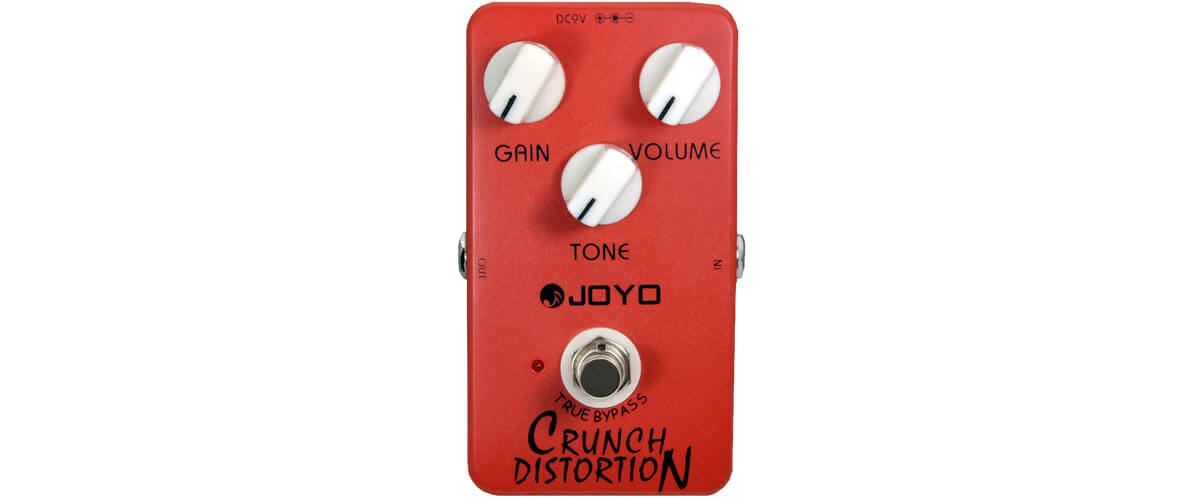
The JF-03 is very compact and lightweight because it's made of aluminum. But it is very durable and can last you for years, so feel free to stomp on it. The pedal measures 4.6 inches, 2.8 inches, and 2.2 inches and weighs 11.6 ounces, so you can literally carry it in your pocket, which is great for constant touring. Its rich red color and On/Off indicator won't leave it invisible, and you're sure to find it in the dark. Also, the white knobs of the Gain, Level, and Tone knobs that stand out in the red can help. The switch pedal is metal and shaped like a round button, as well as the standard IN and OUT jacks on the sides. Nothing extra, understated, stylish, yet bright. I love it.
Features
Well, the JOYO JF-03 features let you have a hard, responsive distortion reminiscent of British amps with high gain. It's classic rock, even if you set the Gain to the middle. You get everything you expected from this style - harmonics, punch, and cascading gain. You'll discover new facets of its sound when you connect the JOYO JF-03 to a circuit. For example, if you turn down your guitar's volume, you might hear something unsightly. That's why you can use an extra pedal in the chain in front of the JF-03 to boost the treble.
Sound
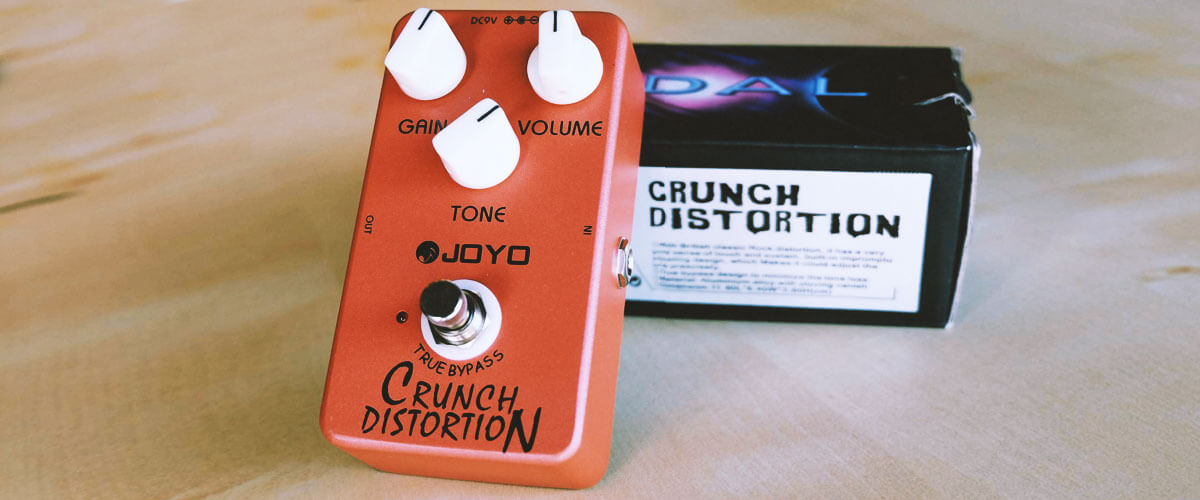
As for the sound, you'll have to experiment. Set the gain to zero and increase the volume for cleaner gain, or, to get that famous Marshall overdriven sound, turn the volume down and increase the gain, creating true rock and roll tones. Lower gain settings create great AC/DC-style tones. Setting the gain to medium gets you into Guns N 'Roses territory, and maximizing the gain gets you to classic Ozzy Osbourne, Iron Maiden, and Metallica gain levels.
If you like old-school rock, this pedal is for you. Considering its price on the market, you will definitely not miss out! Anyway, every musician should choose their own equipment according to their taste. And for that, you must do a lot of work: try new things, experiment, and never stop.
Key specs
- Controls: pedal switch, tone, level, dist, EQ mid freq, EQ high freq, EQ low freq.
- Connectors: input jack: 1/4-inch, output jack: 1/4-inch, DC IN jack.
- Power Supply: Carbon-zinc battery (9V, 6F22), DC adaptor (9V).
- Size (WxDxH), inch/cm: 2.8x4.7x2.1/7.2x12x5.5.
- Weight oz/g: 10/290.
This cheap distortion pedal is modeled after the MI Audio Crunchbox, so the British rock of the 60s and 70s is a hard, responsive distortion reminiscent of high-gain amps. You get everything you’d expect from this style – harmonics, punch, cascading gain – all. When you plug the JOYO JF-03 into your circuit, you’ll be pleasantly surprised by its capabilities at such a low price.
Pro Co RAT2
In 1978, in the basement of a Pro Co store in Kalamazoo, Michigan, Scott Burmam created an effect pedal. This device has undergone some changes since then, but the original circuitry has remained the same. And today, in the Pro Co RAT2 review, I will tell you about this now-famous pedal made by the Chinese company Neutrik for Pro Co. It is designed for fuzz and distortion in equal measure, where smoothness overrides sharpness. So let's take a closer look at it.
Build and design
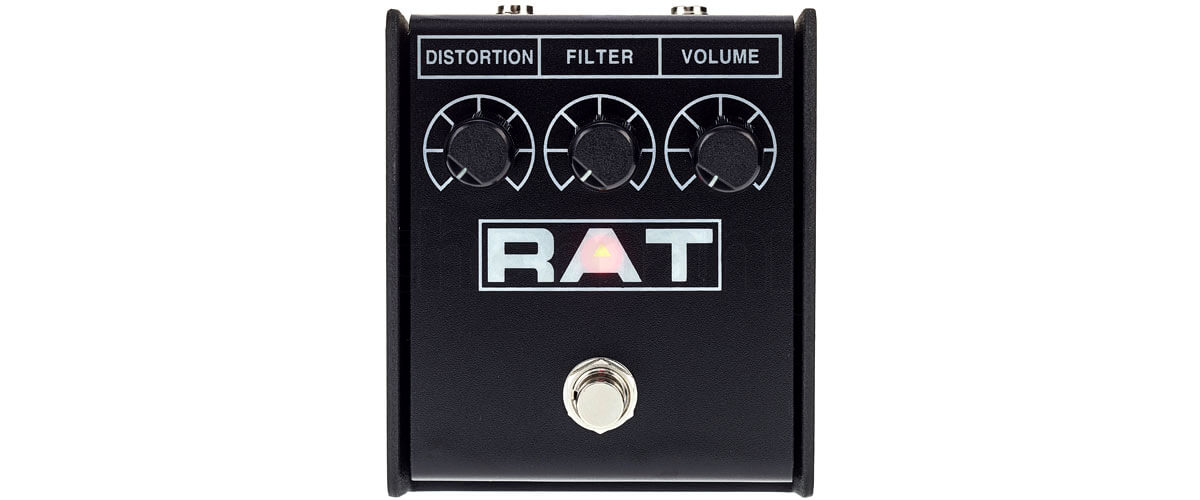
The cute little pedal has an understated design in black with glow-in-the-dark graphics. So it's visible on your pedalboard in the dark. The Rat 2 gives the impression of being indestructible, and it really is. Measuring 2.5 inches, 3.5 inches, and 4 inches, and weighing 2 pounds, it has a classic practical steel body and metal panels on the sides. The heavy-duty industrial pedal switches, three knobs, and connectors can also handle a lot, making it definitely suitable for concert activities. Circuit connectors are located on the top panel of the sidewall next to the DC connector, and there is also an On/Off LED indicator and a battery compartment on the back. Everything is simple and to the point.
Features
Pro Co RAT2 features are as simple as its design. But that doesn't stop it from being versatile. To start with, the pedal runs on 9V batteries and the RPS2 power supply adapter, which are not included in the kit. In addition, it has standard ¼" jacks, a 100% analog signal path, a military-grade glass-epoxy circuit board, and a True Bypass. There are also three controls, Distortion, Volume, and Filter, which rotate virtually 360 degrees, allowing for an extremely wide range of tuning.
As I said before, the pedal finds a balance somewhere between distortion and fuzz. Indeed, by turning the knob to the limit, you can get one effect or another, depending on what you're playing. The Filter is designed to regulate high and low frequencies. All in all, by playing around with the settings, you will get unexpected results. But take your time. Better yet, listen to RAT2 before you buy it. In my opinion and musical taste, it is perfect for classic rock or grunge. But metal lovers will find it lacking in dirt and compression.
Sound
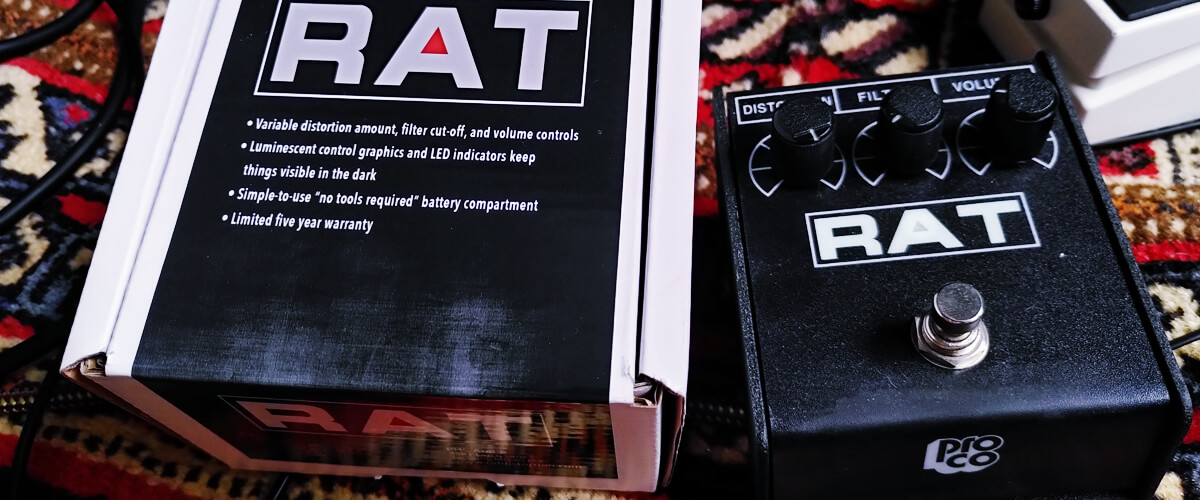
In conclusion, I can only say one thing: this pedal will undoubtedly find its fans, even though it does not have any one unique quality. It's all about the range of its capabilities. It is definitely not suitable for heavy styles of music, but in grunge, classic rock Pro Co RAT2 sounds great. The proof of that is the fact that Kurt Cobain used it. And he's not the only one! Thom Yorke, James Hetfield, and David Gilmour are also among the users. If you take the time to experiment with its knobs, tune it, and play it back, the RAT2 will give you the credit you deserve. And taking into account its affordable price, I can put it in a worthy competitive place among other pedals.
Key specs
- Controls: pedal switch, filter, volume, distortion.
- Connectors: input jack: 1/4-inch, output jack: 1/4-inch, DC IN jack.
- Power Supply: battery (9V), DC adaptor (9V).
- Size (WxDxH), inch/cm: 3.5x4x2.5/8.8x10.1x6.3.
- Weight oz/g: 32/907.
This affordable distortion pedal is designed for fuzz and distortion in equal measure, where smoothness overrides sharpness. It is definitely not suitable for heavy music styles, but grunge and classic rock Pro Co RAT2 sounds great. Proof of this is the fact that it has been used by Kurt Cobain, Thom Yorke, James Hetfield, and David Gilmour.
FAQ
How to use a distortion pedal?
What type of cable plugs into a guitar distortion pedal?
When you build a pedalboard, you will be faced with the task of connecting the pedals to each other. To do this, you will need what is called “patch cables.” These short cables make the circuit look neat, and you don’t get tangled in the wires underfoot.

